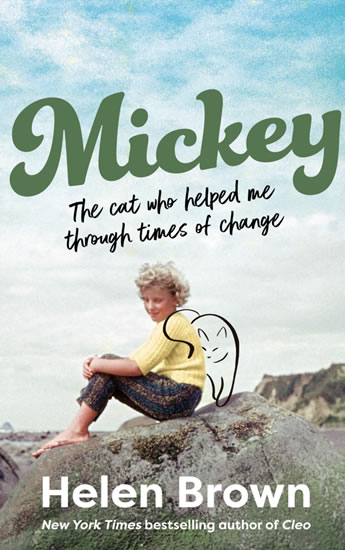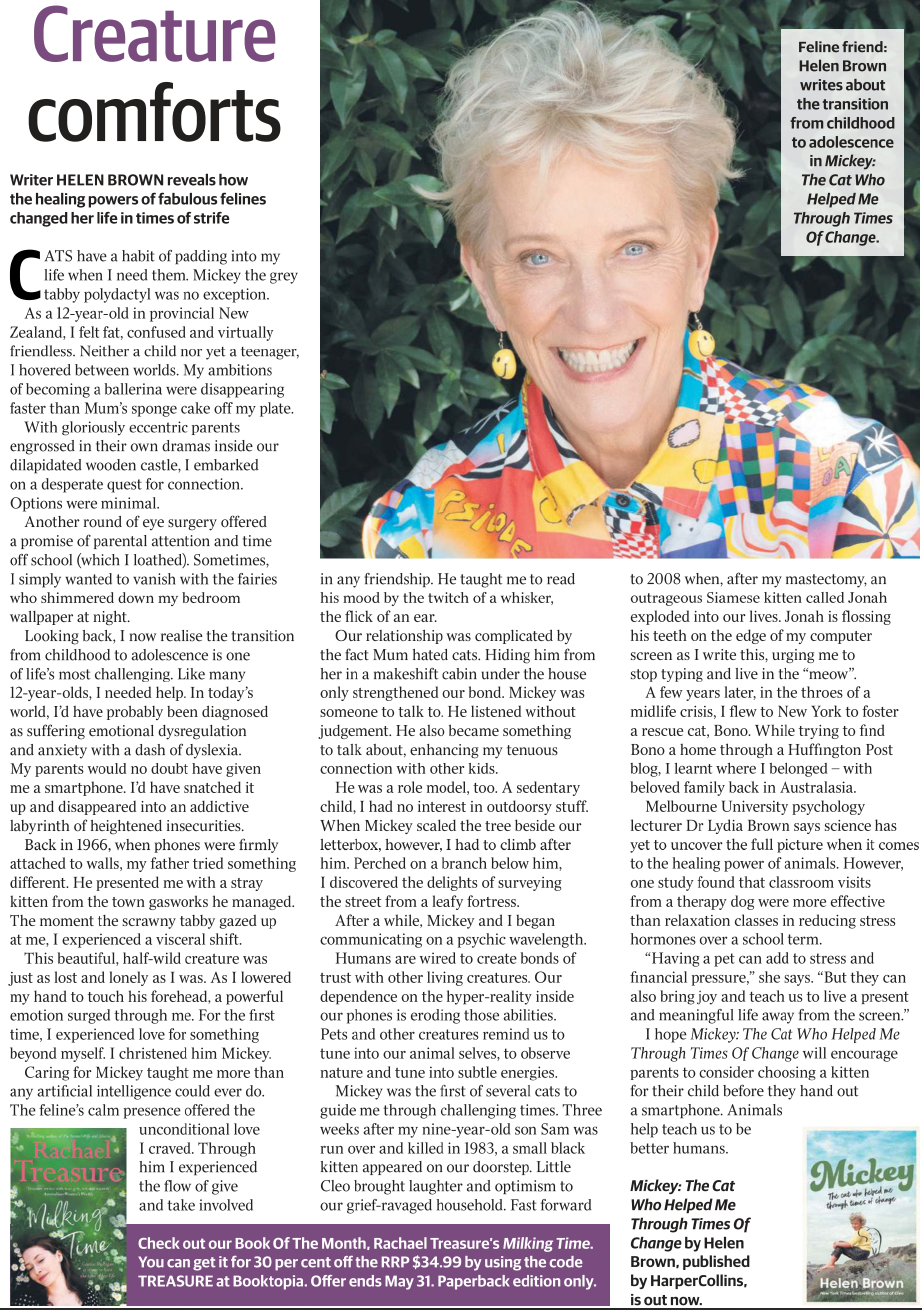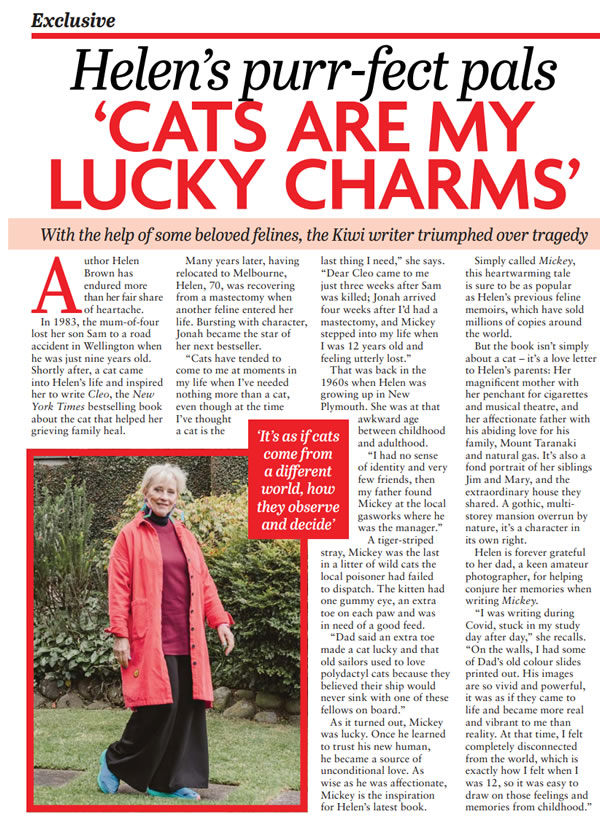Mickey – the cat who raised me
A witty and warm memoir about growing up with the help of a very special cat.
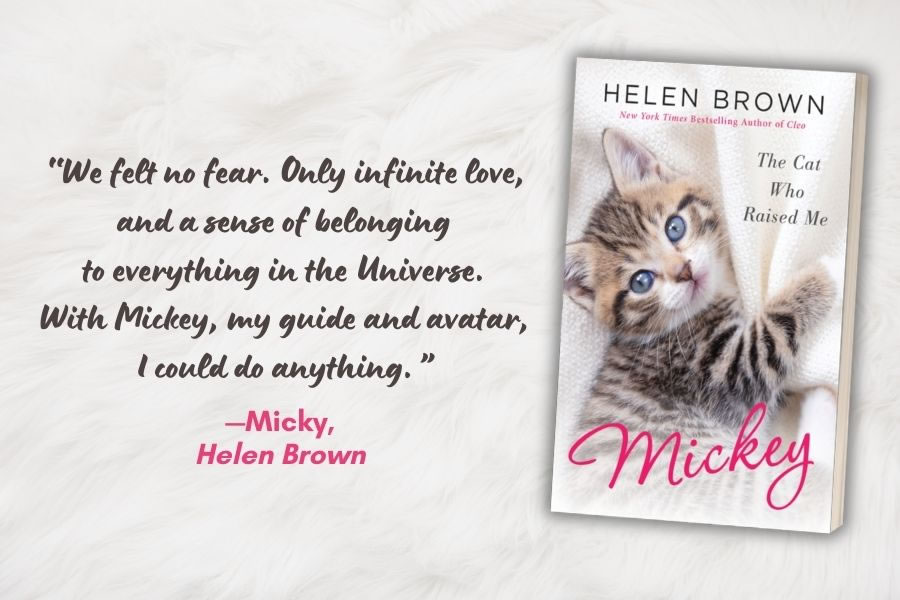
ABC Radio Newcastle Interview
Click here to listen to the ABC Radio Newcastle Interview
ABC Radio Melb interview
Click here to listen to a sample of the audio book from Audible
“Tender, direct, wise and brilliantly funny. I absolutely loved reading this book.”
— Prof Deirdre Coleman FAHA
“A multi-layered , nostalgic and portentous book. There’s history here in these pages.”
– Jude McGee
“Helen Brown is an excellent storyteller who has woven her magic yet again with MICKEY”
– Ruth Vant. UK
“A magical fairy tale. I’m not sure what I expected from this book, but what I got is 10 times better.”
– Educator 985113 Goodreads
“Helen’s books are more than the story of one individual cat; they are meditations on the human experience.”
– Jeanne Powers, Bristol Public Library, Virginia/Tennessee USA.
Book Launch speech by Prof Deirdre Coleman FAHA
Thank you Helen for inviting me to say a few words about your latest book: Mickey: The Cat who raised me (2024)
I first met Helen in 2007, at a function here in Melbourne designed to prop us up while our school-age girls were incommunicado — up-country Victoria for an entire year. Helen and I liked each other immediately, in good part because we very quickly established that we were both writers – Helen, an award-winning New-Zealand columnist, TV presenter, and scriptwriter, and me a much less well-known academic.
Since that year (which seems so close and yet is so distant), Helen has rocketed to international fame with the landmark publication of her NYT Bestseller, Cleo: the Cat who mended a family, her 2010 book which has been read and admired by millions and translated into 18 different languages. This triumph was followed in 2012 by the sequel, Jonah, the story of her current Siamese, an elegant and posh puss. A very different socio-economic cat followed, Bono the shelter cat, a sick and needy Persian, a homeless victim of New York’s Hurricane Sandy! All 3 books are tender, heart-warming stories that speak to the complex emotional bonds we experience with animals, gently probing how felines read and respond to our moods, often helping us to heal when sorrowing, but also bringing joy through their comically quirky looks and personalities. Having firmly established her international reputationwith this troika of cat tales, Helen then applied her terrific energy and imagination to a children’s picture book, Cleo and Rob (published 2019), a brave venture which, with the aid of beautiful illustrations, broaches the almost taboo topic of death for young readers, this being (of course) the loss of Rob’s sibling Sam when Sam was 9 and Rob only 6. As Helen has rightly argued, while we have words like orphan, or widow and widower, there’s no name for a child who loses a sibling. This generic flexibility and daring morphed again with Helen’s next book, her novel, Tumbledown Manor. And now we have Mickey: The Cat who raised me, the most recent star in this sparkling galaxy of publications — the story of her long-lost but not forgotten childhood friend, a charismatic polydactyl with extra toes on her front paws. It was this cat Mickey who helped the 12-year-old Helen navigate her way through a lonely, self-conscious, awkward adolescence, the youngest of a family full of larger-than-life personalities.
I absolutely loved reading this book. It is a book which draws you into its world of the mid 1960s, with a setting in New Plymouth, New Zealand. The world re-created here may seem remote but it was a world far from impervious to the global geopolitics of that time: the cold war, the Vietnam war, and nuclear testing in the Pacific, with its dire legacies of environmental destruction and human illness. It’s also a book alive to the developing consciousness and identity of a sharply observant girl who does not miss the advent of the miniskirt, new musical styles, the sounds of the Beatles and (as Helen puts it) ‘something called The Pill’!
I was born the same year as Helen so I love how she brings that era back to life – the ways in which people and kids dressed — for instance, the winklepicker shoes sported by her young neighbour Shane, footwear beloved by the Teddy Boys of those times. Also the food Helen has so wittily recreated for us: devils on horseback (she has such a funny description of the difficulty of wrangling these bacon and prune concoctions into a neat mouthful) as well as the cheese and pineapple cubes threaded onto toothpicks, and topped with crimson cherries. Marvellous! Even more prominent in the story is the era’s music, especially musical theatre, captured brilliantly in the hugely successful film, The King and I, with Helen’s mother Noeline longing to sing the role of Lady Thiang which included the signature contral to number which we all loved so much, when growing up: ‘Something Wonderful’.
In many ways Noeline sits at the heart of this book. Looking back, Helen can see how her mother embodied all the contradictions of this mid-20 th century era: a clever and ambitious woman, tall, theatrical, resplendent in a yellow satin kimono, but (as a wife and mother with 3 children) forced to make do with the limited options available, such as part-time journalism. One assignment involves coverage of the ‘bride of the year’, a contest her mother had once likened to a cattle show. Humorous as this might be, the frustration is there in Noeline’s eczema-ravaged hands, a painful symptom which she disguised with elegant gloves. In a nice symmetry Noeline’s failure to secure the part of Lady Thiang is simultaneously mirrored by Helen’s own humiliating role in the school play. Here we see Helen posing as a mud-puddle, trodden underfoot by her arch-rival who (of course!) has the lead role as a dancing sun goddess. Other characters include Helen’s kindly Dad, a manager of the local gasworks, her brother Jim in his secretive museum of taxidermy, and her older sister, Mary, a key ally in Helen’s quest to install Mickey into the living heart of the family’s home. These characters are all marvellously created, together with a host of more minor dramatis personae, such as Helen’s maiden aunt Lila ‘with a mind sharper than a dentist’s probe’ (Helen’s witty phrase) or Eric, the town’s part-time theatre director, blessed with God-given powers to ‘snap off aspiring performers’ wings and let them die in their day jobs’ – but equally Eric has the power to transform those around him, working magic on the ‘dullest bank clerk’. At every point Helen reminds us that life is a performance in which transformation is a possibility – but more often it’s a matter of rising to the occasion, dealing with what life throws at us – be that failing to clinch the leading role, or other more serious, troubling, traumatic challenges.
That said, the world that Helen has created for us is delightful – it’s a deeply engaging world, full of wonder and imaginative game-play. But there is also a need to escape the turbulence – to find refuge inside a child’s head. It is to all these vibes (these emotional ups and downs) that Helen’s home reverberates, itself a bustling castle painted lime green. Architecturally this house is incredibly alive – it is one of the book’s best creations, as alive as the characters living under its multi-storeyed but dilapidated eaves. In contrast stands a very different character, Mt Taranaki, a massively fixed, unchanging reference point throughout. Described abstractly by Helen as a ‘vast white triangle’, Mt Taranaki dominates New Plymouth’s townspeople, a symbol of the natural world’s sublime indifference to those who live beneath its all-knowing, eternal gaze.
Some of you might recently have read Yellowface and learned something of how complex and challenging the publishing industry can be, dealing with agents, editors, deadlines, and publishers. Worst of all, the identity politics around who does and doesn’t get their voice heard. Helen, with her many millions of readers and admirers, towers above all this, the reason being the quality of her voice: a voice which is tender, direct, wise, and brilliantly funny!
Congratulations to you Helen. Mickey did indeed teach you how to keep an open heart and live in the meow!
I declare Mickey launched! Don’t miss the opportunity of buying an autographed copy!
Reviews
Mickey: The Cat Who Raised Me by Helen Brown
Review by the Reference Department of the Bristol Public Library, Bristol, Virginia/Tennessee.
Reviewed by Jeanne
I have been trying to find a way to do a decent review of this book, but it has been a struggle. Not because I didn’t like it—spoiler alert, I loved it!—but because like many of Helen Brown’s books it isn’t something you can sum up in a quick tag line. Oh, you could, but to do so would be to miss the depth and nuances which I love and which make all her books instant “must reads” for me.
Helen is twelve years old in 1966, growing up in a small town in New Zealand. Her father is an engineer, a champion of using natural gas which is not an easy sell. Her mother is devoted to theatre and the arts, a mercurial personality who throws herself into preparing for local theatrical productions. Helen has two older siblings, a sister who has at times been more maternal than her mother, and a brother who is a budding taxidermist. Helen sometimes feels lost and unnoticed. She doesn’t seem to fit in. She struggles in school, is teased as “Helen the Melon,” and is facing eye surgery.
Then one day her father takes her to pick up a scraggly kitten, sole survivor of a litter. Helen names him Mickey but has to hide him from her mother who dislikes cats. To Helen’s dismay, Mickey seems disinclined to accept her overtures of friendship and instead promises to upend the household. It’s up to Helen to keep Mickey alive and a secret.
It seems strange to think that a girl in New Zealand would have all that much in common with a girl growing up in Appalachia, but there were so many times that I totally related to what was going on in Helen’s life. While I didn’t see atomic bomb tests on nearby islands, I certainly remember packing sandbags against basement windows and the old atomic signs to show us where to hide in the school in case of nuclear war. Figuring out who your favorite Beatle was, the benign neglect of parents who let you explore and play without direct supervision, and trying to fit in among your peers is all familiar territory. So many half-forgotten memories appeared as I read this book that I would have to stop and ponder.
While most of her books revolve around a cat—Cleo, Jonah, or Bono, previously—it’s a mistake to dismiss them as “just a cat book.” Not that I have anything against cat books! It’s why I picked up Cleo all those years ago. But Helen’s books are more than the story of one individual cat; they are mediations on the human experience.
Most of all, Helen Brown has the gift of storytelling, of describing scenes so vividly that the reader can almost see them. She also knows how to find that point of connection between people and make different experiences relatable, and has a delightful sense of humor. I have always found reading her books to be like talking with an old and dear friend, and this one is no exception.
I now want to go back and re-read her other wonderful books, Cleo: The Cat Who Mended a Family; Cats and Daughters: They Don’t Always Come When Called; Bono; and her novel, Tumbedown Manor. I know there will be laughter, tears, warmth, and love.
Original post – https://bristol-library-bookblog.blogspot.com/2024/05/mickey-cat-who-raised-me-by-helen-brown.html
Brown’s new book, Mickey, about love and connection
Helen Harvey, May 25, 2024, stuff.co.nz
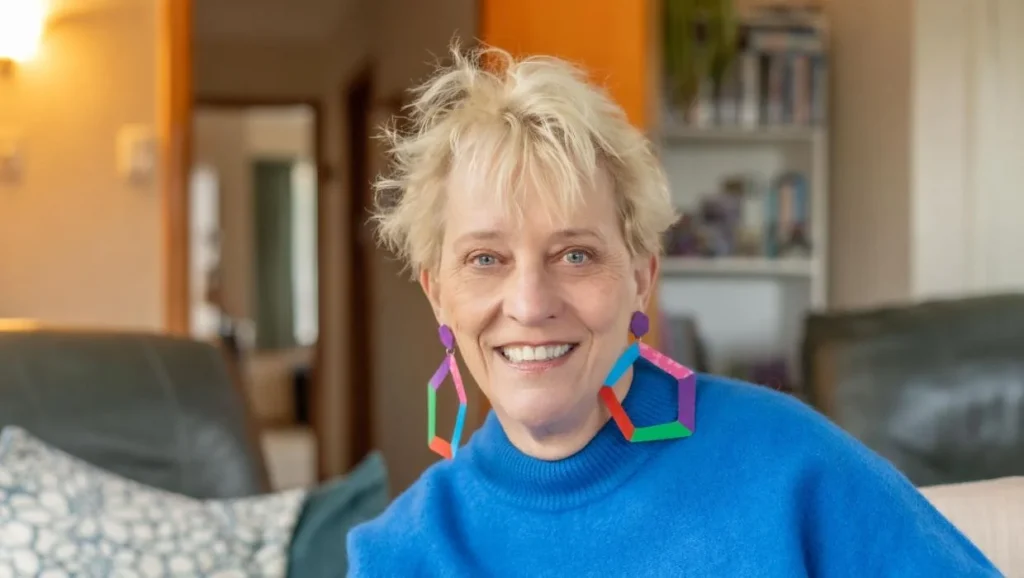
Author Helen Brown is back home in New Plymouth talking about her new book Mickey, which tells the story of Brown as a 12-year-old living in 1966 New Plymouth.
LISA BURD / TARANAKI DAILY NEWS
When author Helen Brown was being interviewed for an American podcast she was asked if her childhood left her traumatised.
They were discussing Brown’s new book Mickey, that covers Brown’s life in 1966 when she was 12 years old and living with her parents and older siblings in New Plymouth.
The interviewer said “your family was insane and your mother was such a narcissist and you were bullied and people called you a melon, how did you survive?” Brown explained.
“I said ‘I don’t think it was like that’. I feel grateful. She thought I perhaps should be more upset and traumatised.”
Back then Brown was Helen Blackman and living in Bracken St in an old house that still has a hold on her.
This week the current owners let her go back to the house for a magazine photo shoot to promote her book, she said.
“It was built in 1913 I think. We lived in it when that sort of house was unfashionable and no-one wanted it. And so I think [parents] got it very cheaply. Dad was the gas works manager. We weren’t wealthy enough to do big glamorous things to it. So we just lived in it and it was wonderful. It created us.”

Brown says she has a spiritual connection to the house she grew up in on Bracken St, New Plymouth.
VANESSA LAURIE / TARANAKI DAILY NEWS
She still feels a spiritual connection to it, because the house is so unusual.
“Our lives were so rich with imagination and that house nurtured that.”
Being 12 years old and living in New Plymouth in 1966 was magical, the former Taranaki Daily News columnist said.
“It was also very challenging for a plump 12-year-old who didn’t have very many friends and didn’t play sport. Who ate a lot, but nevertheless wanted to be a prima ballerina like Dame Margot Fonteyn.”
And 1966 was a challenging time with nuclear testing in the Pacific, the tensions between Russia and the USA, the Vietnam War.
And World War II was still very real to them, she said.
“You’d see men walking down Devon St with one arm.”
She mentions in the book how she would roll down the sandhills at Back Beach and see the streams that were “violent orange”, which she believed was caused by run off from the Ivon Watkins Dow plant.
“Mum used to say ‘no don’t wade through that, no dear, not in bare feet’.”
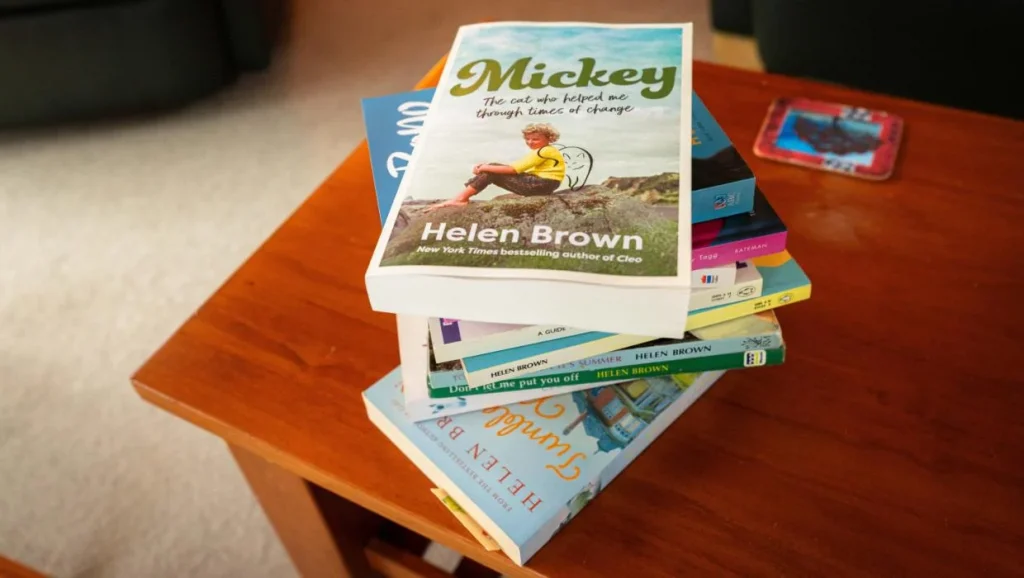
Brown’s new book Mickey is available at all bookstores.
LISA BURD / TARANAKI DAILY NEWS
But Mickey is not entirely non fiction, she said.
“Some of the characters are fictionalised and the events are, some of them. Timelines have been melded and the characters are combined, so it’s a bit of fanciful journey. But there’s a strong element of truth in it and the main truth is love really, the love I felt for my cat and parents and family and surroundings.”
Like her other non fiction books, Mickey, is centred around a cat and its influence on her life.
Brown said she wasn’t good socially back then, because they were very much a one of a kind family and she was lonely.
“When I think of how I was a bit withdrawn – today I would be given an iPhone.”
But back then her father gave her a cat.
“I think you have to be taught how to love, and caring for something that’s dependant on you is a big step towards that, and he taught me how to love. He was a deeply calming influence on me, even though we had to hide him in that big house, because mum hated cats. And Mickey listened and no-one else really wanted to listen to me.”
For the first time she had a deep emotional connection with something outside of herself.
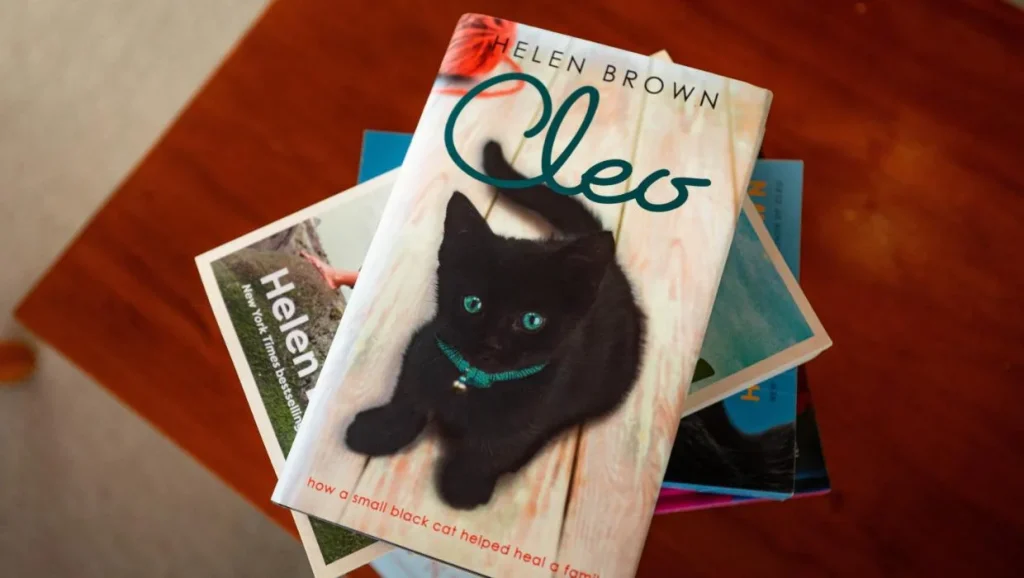
Brown’s first book, Cleo, was also about a cat’s influence on her life. It has sold 2 million copies.
LISA BURD / TARANAKI DAILY NEWS
The earlier feeling of being disconnected came back during Covid, she said.
“I felt so starved of connection. And I had some of Dad’s slides printed and up on my wall, he was a wonderful photographer, from that era and they started beaming down at me. And I remembered the last time I had felt this disconnected. It was when I was 12.”
Those slides became more real than life while she was writing the book, she said.
And it seemed natural to include Mickey, just as she had included another, Cleo, in her best-selling first book – Cleo.
Brown used to write columns for the Taranaki Daily News as well as six other newspapers around New Zealand. After her family moved to Australia, she thought she’d write a book, she said.
“I thought I’d pull out ideas for it from the columns I got the most response from readers. They were without doubt about this black cat Cleo and how she helped us after my son Sam was run over and killed in 1983. So I built on that and filled in the gaps.”
Cleo has sold two million copies and has been translated into 18 languages.
Brown still lives in Melbourne, where her house is full of pictures and prints of Taranaki Maunga.
“If you were been born under that mountain it never leaves you. You carry it with you, inside you, for the rest of your life.”
Mickey is available at all book shops.
– Taranaki Daily News

